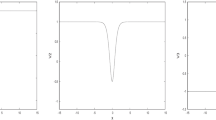Summary
A simulation study is reported of the spread of excitation in a digital computer model based quite realistically on a coelenterate nerve net. The question posed is whether an elementary nervous system with randomly distributed properties can discriminate between time patterns of stimuli at the same average frequency. Forty-four temporal patterns of stimulation, each composed of seven stimuli in the same total period of time were applied to each of nine simulated nerve nets with each of eleven different distributions of four rates of decay of facilitation. The results may be summarized as follows:
-
1.
The simulated nerve nets used were able reliably to discriminate between many of the time patterns used. The factors entering into range and acuity of pattern discrimination by the net are identified.
-
2.
The simulated nerve nets tended to support a greater spread of excitation in response to even temporal distribution of stimuli than in response to clustered distributions of stimuli under certain conditions. These conditions are specified.
-
3.
The response measure which was used (“final spread”) is shown to give different results in some cases than either of two other measures (“average” spread for the seven stimuli and “maximum spread”).
-
4.
The simulated nerve nets were able to produce reliable differences in the spread of excitation between certain patterns and their temporally mirror-image counterparts. The necessary conditions for such pattern recognition are described.
The relationships among the principal variables, namely the temporal distribution of stimuli, the specific sequence of junction decay rates, the magnitudes of facilitation decay rates, and their relative frequency distributions are described as they affect the spread of excitation in the nerve net. The overall finding that the net is able to discriminate between some temporal patterns gathers significance in that it represents an ability of the net to translate temporally coded information into spatial form. Thus, it is shown that already at the level of a simplified model of a coelenterate nervous system, the requisites for temporal to spatial translation are met.
Similar content being viewed by others
Literatur
Batham, E.J., C. F. A. Pantin, and E. A. Robson: The nerve net of the sea anemone Metridium senile; the mesenteries and the column. Quart. J. micr. Sci. 101, 487–510 (1960).
Bullock, T. H.: The functional organization of the nervous system of Enteropneusta. Biol. Bull. 79, 91–113 (1940a); - The existence of unpolarized synapses. Anat. Rec. 78, Suppl. 67 (1940b) (Abstract); - Anatomical organization of the nervous system of Enteropneusta. Quart. J. micr. Sci. 86, 55–112 (1945); - Comparative aspects of superficial conduction systems in echinoids and asteroids. Amer. Zool. 5, 545–562 (1965); - Physiological bases of behavior. In “Ideas in modern biology” (J. A. Moore, ed.). Garden City, N.Y.: Natural History Press 1965.
Bullock, T. H., and G. A. Horridge: Structure and function in the nervous systems of invertebrates. San Francisco: W.H. Freeman & Co. 1965.
Horridge, G. A.: The co-ordination of the protective retraction of coral polyps. Phil. Trans. ?B240, 495–529 (1957).
Josephson, R. K.: Colonial responses of hydroid polyps. J. exp. Biol. 38, 559–578 (1961 a); - Repetitive potentials following brief electric stimuli in a hydroid. J. exp. Biol. 38, 579–594 (1961 b); - Spontaneous electrical activity in a hydroid polyp. Comp. Biochem. Physiol. 5, 45–58 (1961 c).
Josephson, R. K., R. F. Reiss, and R. M. Worthy: A simulation study of a diffuse conducting system based on coelenterate nerve nets. J. theor. Biol. 1, 460–487 (1961).
Parker, G. H.: The elementary nervous system. Philadelphia: J. B. Lippincott Co. 1919.
Passano, L. M.: Primitive nervous systems. Proc. nat. Acad. Sci. Wash.)(50, 306–313 (1963).
Segundo, J. P., G. P. Moore, L. J. Stensaas, and T. H. Bullock: Sensitivity of neurones in Aplysia to temporal pattern of arriving impulses. J. exp. Biol. 40, 643–667 (1963).
Segundo, J. P., D. H. Perkel, and G. P. Moore: Spike probability in neurones: influence of temporal structure in the train of synaptic events. Kybernetik 3 (2), 67–82 (1966).
Wiersma, C. A. G., and R. T. Adams: The influence of nerve impulse sequence on the contractions of different crustacean muscles. Physiol. comp. ('s-Grav.) 2, 20–33 (1950).
Author information
Authors and Affiliations
Additional information
Aided by grants to Theodore H. Bullock from the National Institutes of Health, the National Science Foundation, and the Office of Naval Research. We gratefully acknowledge use of the Health Sciences Computing Facility and thank Steven Crocker for his assistance in rewriting portions of the nerve net program.
Predoctoral trainee under a program of the Brain Research Institute, supported by the National Institutes of Health. In addition, L. G. Fehmi was partially supported by an ONR contract on which Professor D. B. Lindsley is a principal investigator.
Rights and permissions
About this article
Cite this article
Fehmi, L.G., Bullock, T.H. Discrimination among temporal patterns of stimulation in a computer model of a coelenterate nerve net. Kybernetik 3, 240–249 (1967). https://doi.org/10.1007/BF00288554
Received:
Issue Date:
DOI: https://doi.org/10.1007/BF00288554




